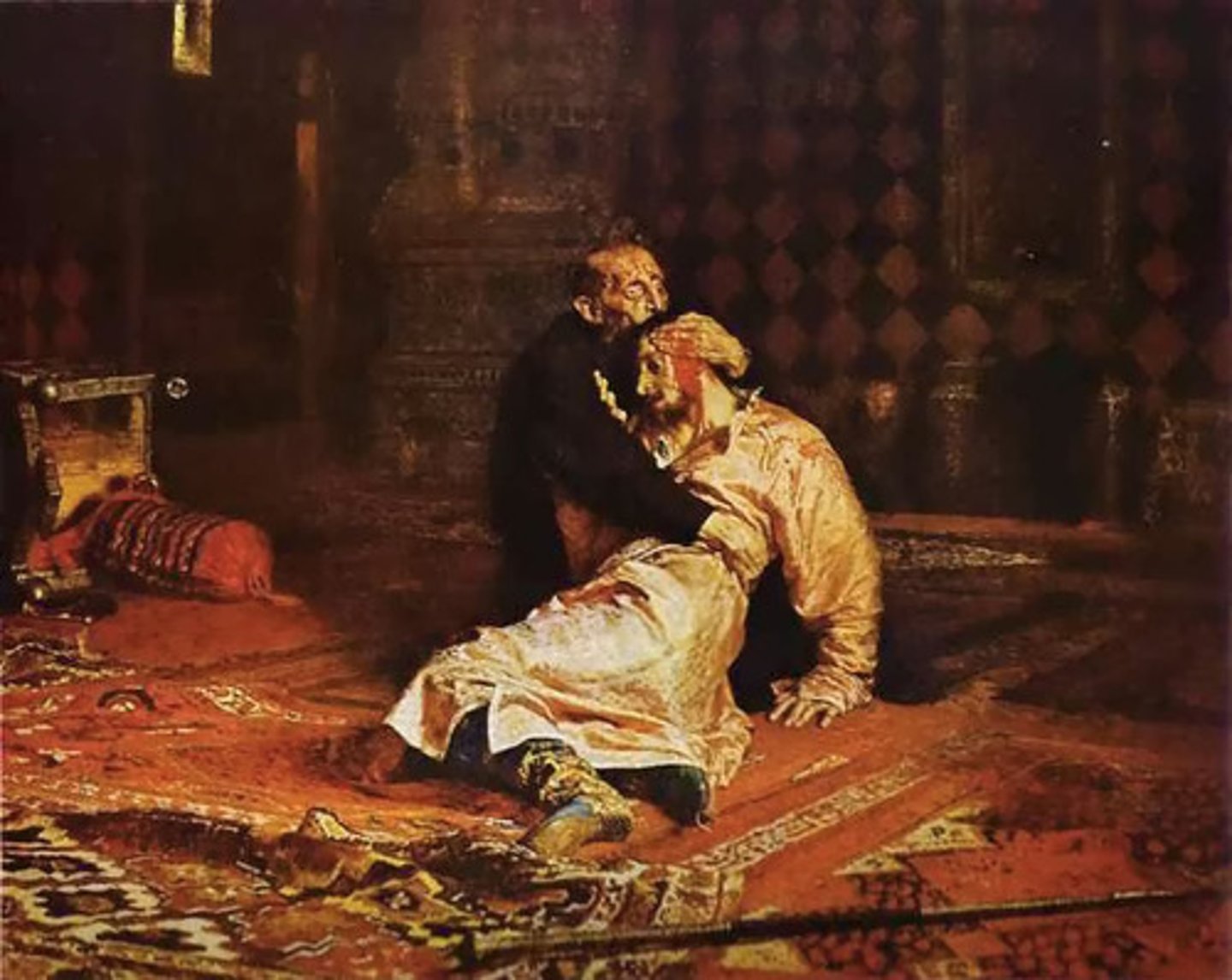UCLA RUSSN 90A
1/94
There's no tags or description
Looks like no tags are added yet.
Name | Mastery | Learn | Test | Matching | Spaced |
|---|
No study sessions yet.
95 Terms
Main Russian Mountains
Caucasus - connects Black and Caspian Seas, Ural - Separates Europe from Asia
Main Russian Seas
Baltic - by Finland, Black - below Ukraine, Azov - East of Crimea
Main Russian Lakes
Baikal - Southern Siberia above Mongolia
Main Russian Rivers
Lena - Siberia (Asia) above Lake Baikal, Volga - below Moscow connecting to Caspian Sea (Europe), Don - connects to Volgograd (Europe), Moskva - in Moscow, Neva - by Saint Petersburg
Which countries used to be a part of the Soviet Union?
Finland (Until 1917), Poland (Until 1918), Alaska (Until 1867), Rest until 1991: Estonia, Latvia, Lithuania (Baltic); Belarus, Ukraine, Moldova (South West); Georgia, Armenia, Azerbaijan (South Caucasus), Kazakhstan, Kyrgyzstan, Turkmenistan, Uzbekistan, Tajikistan (Central Asia)
Main Russian Cities
Saint Petersburg - By Finland, Moscow - Capital, Kazan - East of Moscow before Ural Mountains, Novosibirsk - on Ob River (above Kazakhstan and Mongolia split) , Irkutsk - on Lake Baikal, Vladivostok - by Japan
East Slavic Languages
Russian, Belarusian, Ukrainian
West Slavic Languages
Polish, Czech, Slovak
South Slavic Languages
Western: Slovenian, Serbian/Croatian, Bosnian, Montenegrin (Yugoslavia); Eastern: Bulgarian, Macedonian, Old Church Slavonic (Bulgaria)
What were the three recorded alphabets used in Russia?
Glagolitic (860's), Early Cyrillic (late 9th century), and Contemporary Russian (1710-1918)
Slavic Tribes
Drevlians, Krivichs
Scandinavian Tribes
Varangians
Turkic Peoples
Khazars, Pechenegs, Polovtsy
Byzantium
Also known as Constantinople and today as Istanbul (capital of Turkey), origin of Orthodox Christianity and home of the Hagia Sofia
Old Russian Cities
Novgorod - south of Saint Petersburg, Kiev of Kyiv- capital of Ukraine, Vladimir - East of Moscow
Who was Rurik?
A Varangian chief who was invited to rule the people of Rus at Novgorod in 862 (according to the Primary Chronicle)
Who was Olga?
Regent of Kiev for her son Sviatoslav (945-957), first to get baptized in Rus and took the name Elena. Known for subjugation of Drevlians (the tribe that killed her husband Igor).
Who was Vladimir the Great?
Grandson of Olga who ruled in Kiev (10th century), known for Christianization of Rus (988)
Who was Sviatopolk?
Son of Vladimir known as "the Accursed", infamous for assassinating his brothers Boris, Gleb (1015) and Sviatoslav
When was the Christianization of Rus?
988 by Vladimir the Great
Who were the first Russian saints and when were they canonized?
Boris and Gleb in 1015.
Who was Yaroslav the Wise?
Vladimir's Son who reunited Russian lands under Kiev (11th century), created the law code Russkya Pravda, ushered in golden era for Rus literature and culture after his defeat of his brother Sviatopolk
What happened in 1054?
Yaroslav the Wise dies. The Great Schism between Roman Catholic Church (West) and Eastern Orthodox Church (East).
Who was Vladimir Manomakh?
Yaroslav's grandson (12th century) writes Pouchenie (Instructions) as a moral code for his sons, "Heavy is the crown of Manomakh"
What happened in 1132?
Disintegration of Kievan Rus into smaller principalities after reign of Vladimir Manomakh's son Mstislav. This causes the political center to move to Suzdalia-Vladimir (shift east)
Who was Vsevolod (III) Yurievich (Vsevolod Bolshoe Gnezdo)?
Built Cathedral of Saint Demetrius in Vladimir (1190) and was strongest prince in Rus (1200)
Who was Alexander Yaroslavich?
Otherwise known as Alexander Nevsky, was prince of Novgorod, won against the Swedes at Battle of the Neva River (1240), won against the Livonians at the Battle on the Ice (1241), was Grand Prince of Vladimir (1252-1263)
When did the Mongols attack Rus?
13 century
Who was Batu Khan?
Grandson of Genghis Khan and attacked Rus in 1237 to 1240
When was Ryazan captured by the Mongols?
1237
When was Kiev captured by the Mongols?
1240
What city was failed to be captured by the Mongols?
Novgorod
What is the earliest Rus architectural style?
Russian White Romanesque
What cathedral is this?
Cathedral of Saint Sophia, Kiev (1011-1036)
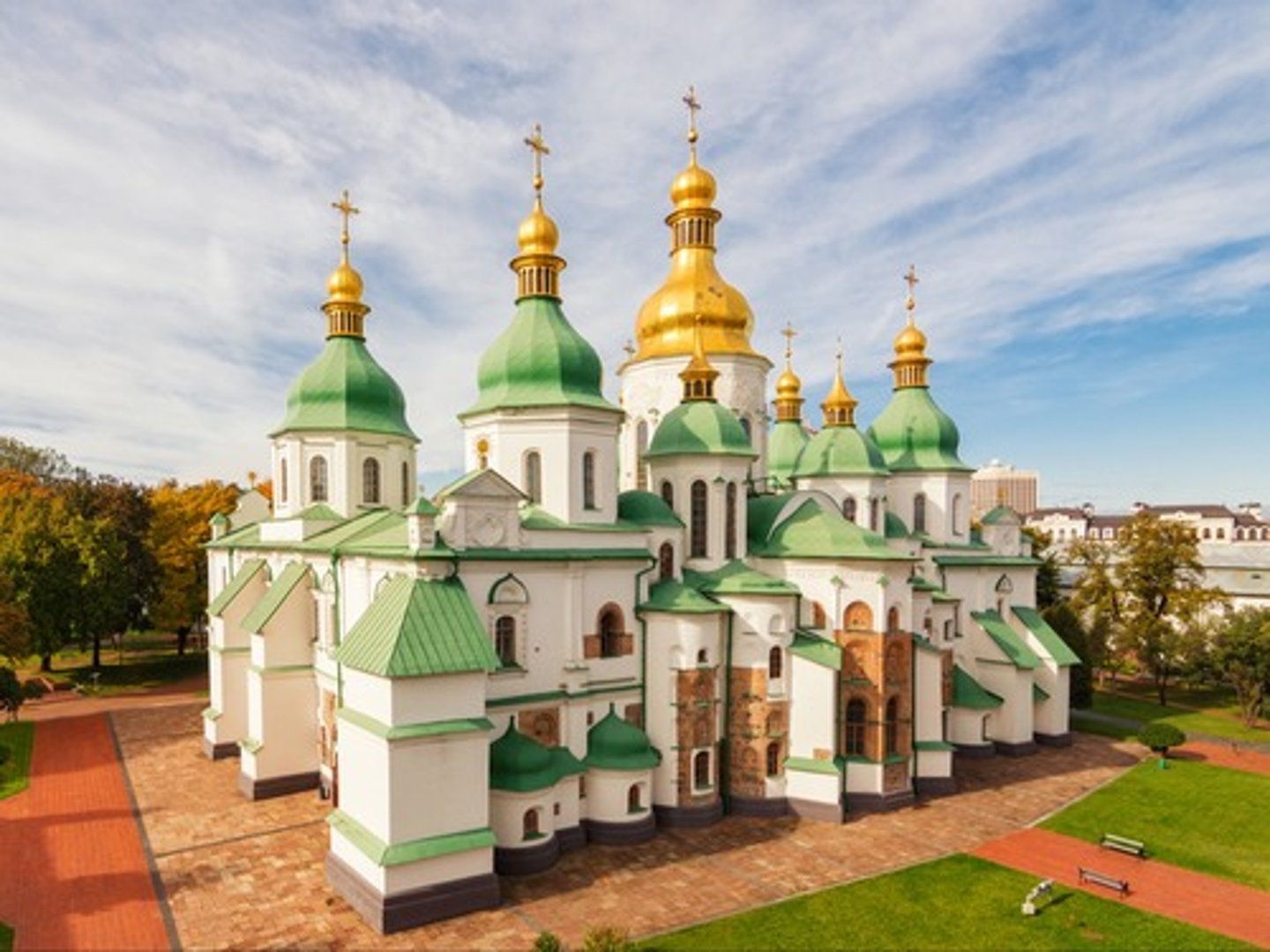
What church is this?
Church of the Intercession on the Nerl (1165-1166) near Vladimir
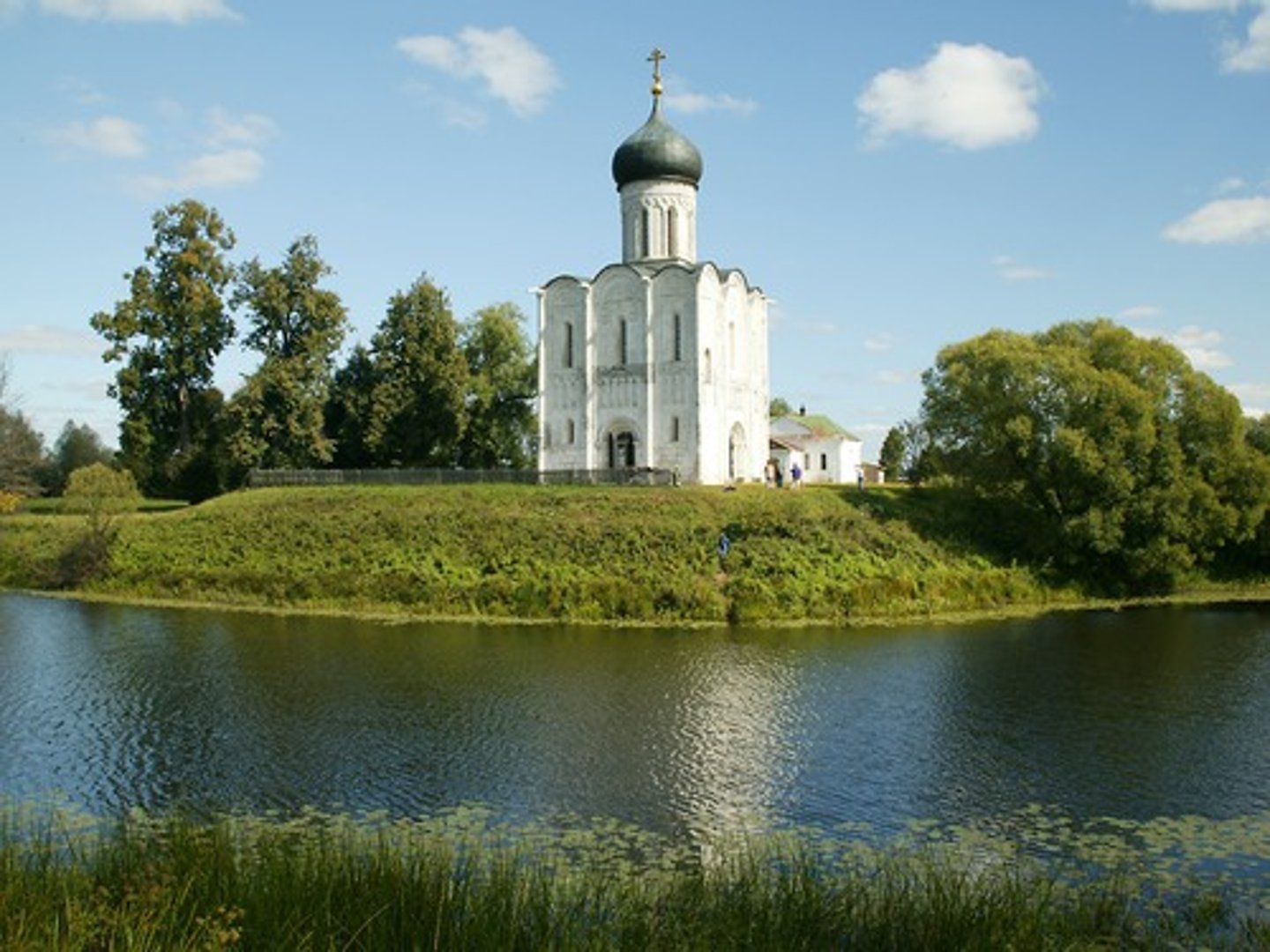
What cathedral is this?
Cathedral of St. Demetrius, Vladimir (1194-1197)
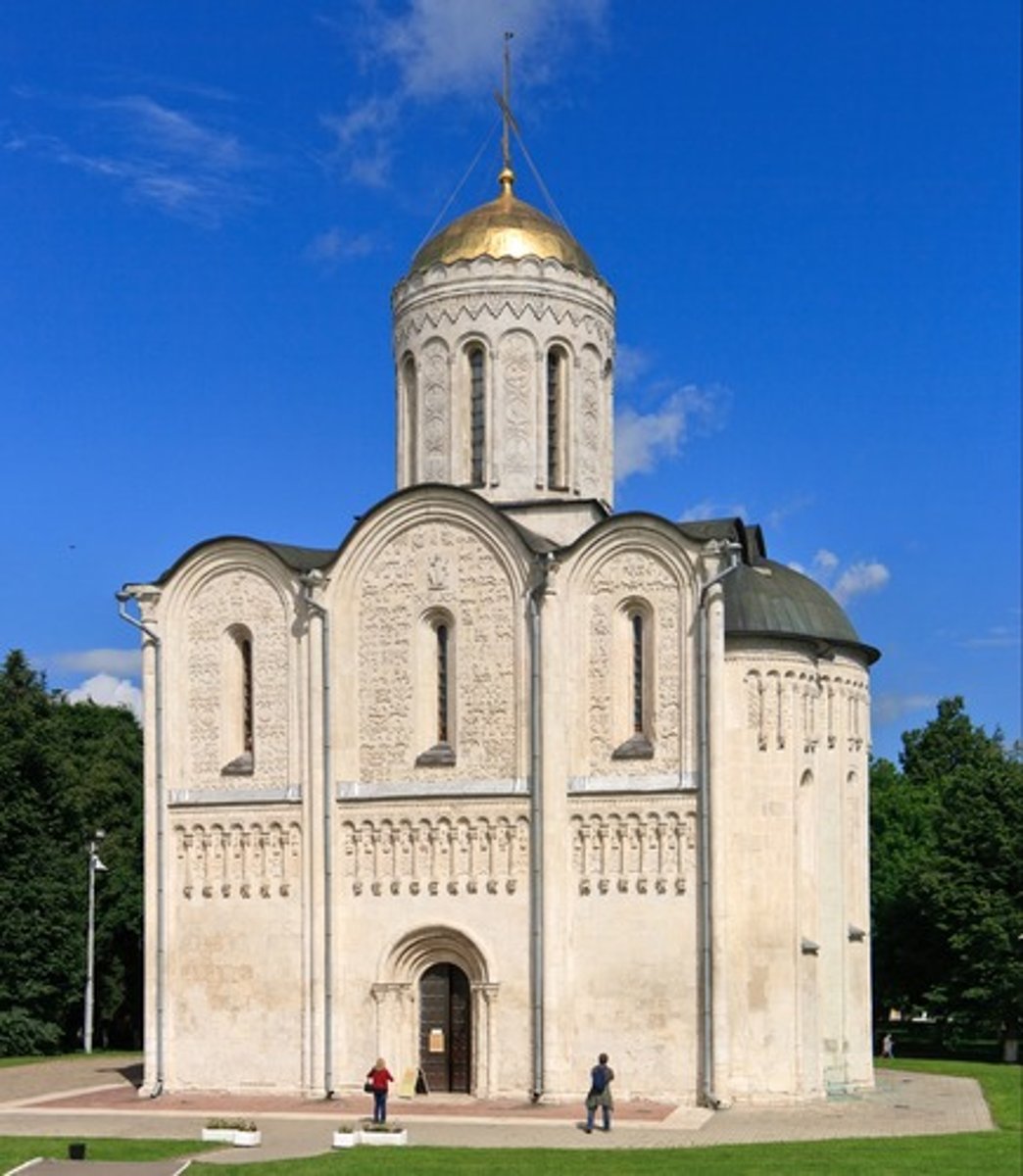
What cathedral is this?
Cathedral of St. Sophia, Novgorod (1043-1050)

What defines folklore?
Oral tradition that has no known author
What are the two main genres of folklore?
Epics (byliny), and fairy tales (skazki)
Who are two main Russian folklorists?
Alexander Afanasyev (19th century) and Vladimir Propp (20th century)
What is normally the main hero in Russian folktales called?
bogatyr or vityaz (warrior/hero)
What is Vladimir Propp known for?
Characterizing Russian folklore into categories. He defines 7 main actants or roles of characters and 31 main functions.
What are the 7 actants as defined by Vladimir Propp?
The villain, the donor, the magical helper, the princess or prize, the dispatcher, the hero, and the false hero.
Who was Viktor Vasnetsov?
Painter of Russian folklore (19th and 20th century)
Who was Ivan Bilibin?
Painter of Russian folklore motifs (20th century)
Name 6 main traditional characters in Russian folktales
Ivan the Fool, Tsarevich Ivan, the Fire Bird, Vasilisa the Beautiful, Baba Yaga, Koshchei the Immortal
Who created this painting and who does it depict?
Painter: Viktor Vasnetsov, "The Three Supermen/Bogatyrs", Dobrynia Nikitich, Ilya of Murom, Alesha Popovich
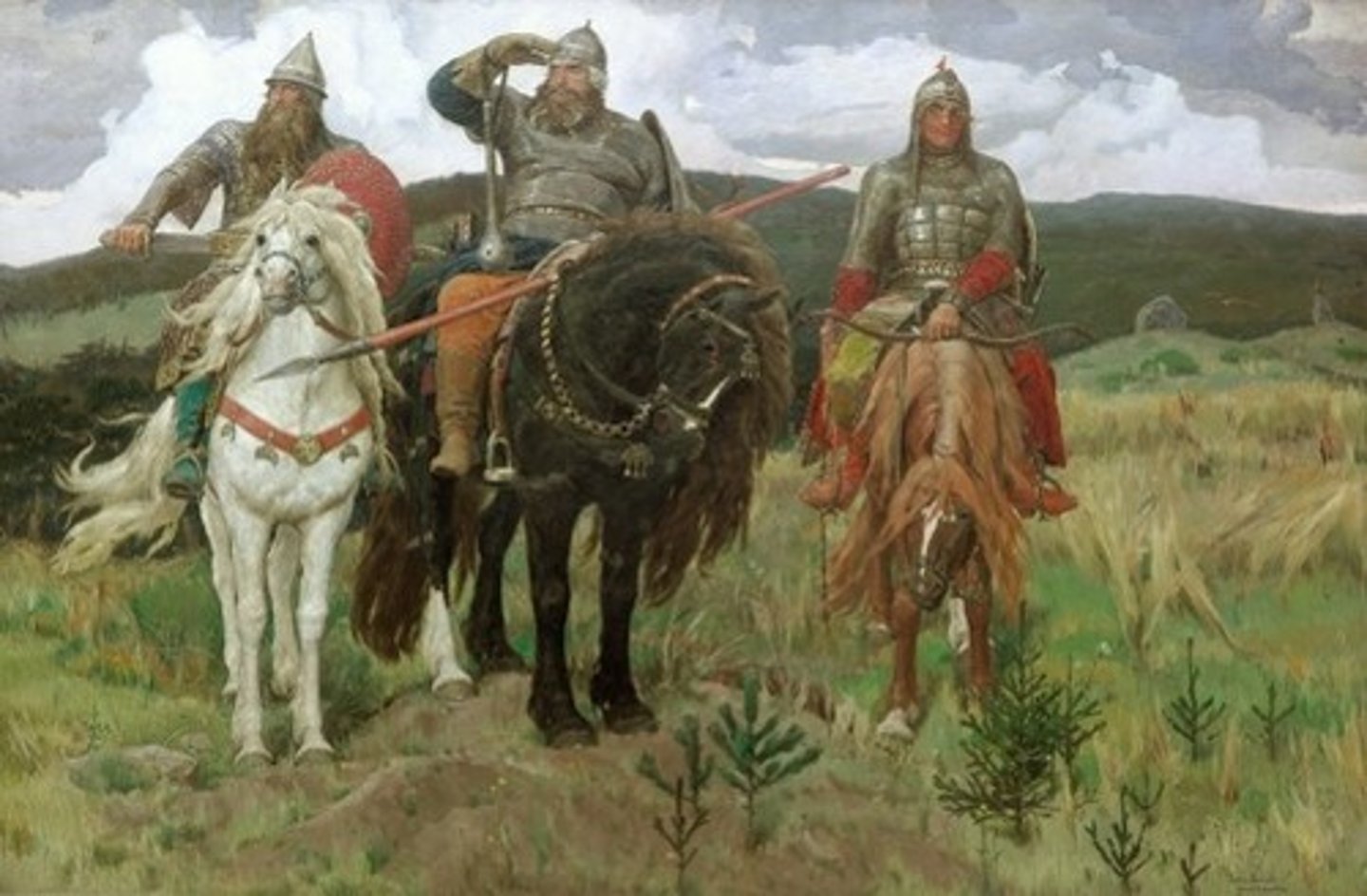
Who was Nikolai Roerich?
Painter who specialized in Russian folklore (1874-1947)
Who painted this and what does it depict?
Painter: Nikolai Roerich, "Ilya of Murom" (1910)
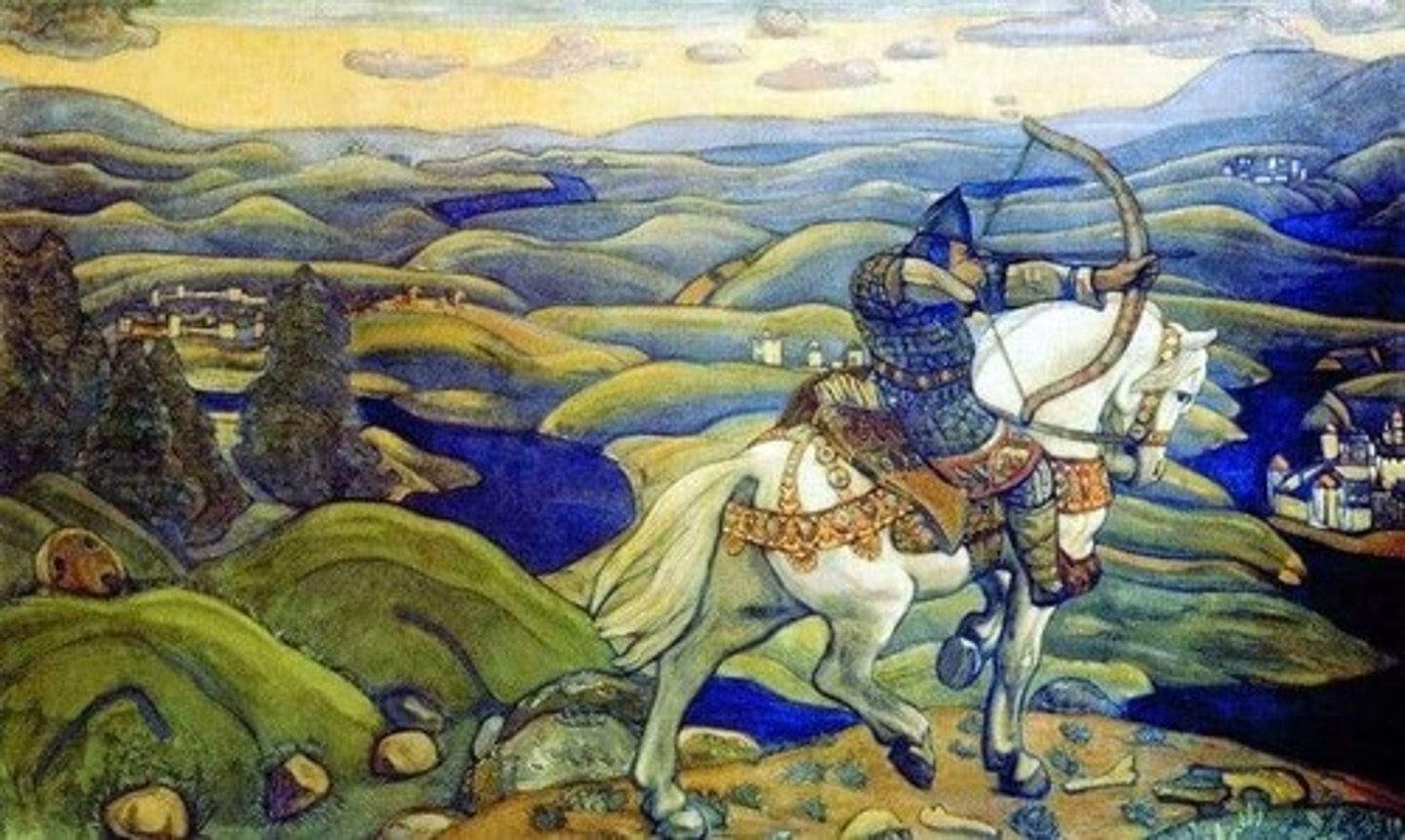
What are the seven main biomes or regions in Russia?
Black Earth, Taiga, Tundra, Steppe, Mixed Forests, Mountain Range, Desert
What is a yarlyk?
Under the Golden Horde, Grand Princes awarded a yarlyk by the Mongol Khan had the right to rule over their respective principality.
Who was Ivan Danilovich?
Also known as Ivan Kalita. Best remembered for his financial shrewdness (Ivan the Moneybag) and ability to acquire wealth. Under his reign, the metropolitan capital moved from Vladimir to Moscow (1288-1340)
Who was Dmitri Ivanovich Donskoi?
Won against the Mongols at the battle of Kulikovo (1380), Tokhtamysh (descendent of Genghis Khan) ravages Moscow (1380), build first white stone Kremlin. In general ruled from 1350-1389
Who was Ivan Vasilievich?
Also known as Ivan Groznyi or Ivan the terrible (1530-1584), violent and harsh ruler that expanded Rus territory and claiming himself as Tsar of all Russia (1547)
What is the Trinity?
God the Father, The Son (Jesus Christ) and the Holy Spirit
Which autocephalous churches composed the Pentarchy?
Rome, Constantinople, Alexandria, Antioch and Jerusalem
What happened in 1453?
The fall of Constantinople as captured by the Ottoman Empire
What is the language of liturgy of Eastern Christianity?
Greek and Old Church Slavonic
What is the language of liturgy of Western Christianity?
Latin, German, English
What is the stance of Eastern Christianity on marriage?
"White" married priests and "black" unmarried priests
What is the stance of Western Christianity on marriage?
Celibacy
What is the role of instruments in Eastern Christianity?
No musical instruments allowed during liturgical services, only the human voice (created by god) can be used
What is the role of instruments in Western Christianity?
Musical instruments can be used.
Can sculpture be used in Eastern Christianity?
No, statues are disavowed as they are considered idols
Are sculptures allowed by Western Christianity?
Yes, sculptures can be used as idols for sacred art
Can paintings be used for sacred art in Eastern Christianity?
Icons can be used to show veneration for a particular event (the paintings are not realistic and are used simply as a method of worship and not art)
Can paintings be used for worship in Western Christianity?
Yes paintings are used in Western Christianity.
What is an icon?
A religious work of art, typically a painting used in Eastern Orthodox Christianity
What is the name of the icon screen that separates the sanctuary from the nave in Russian Orthodox Churches?
The Iconostasis
What is the name of this painting?
Vladimir Mother of God (Our Lady of Vladimir)
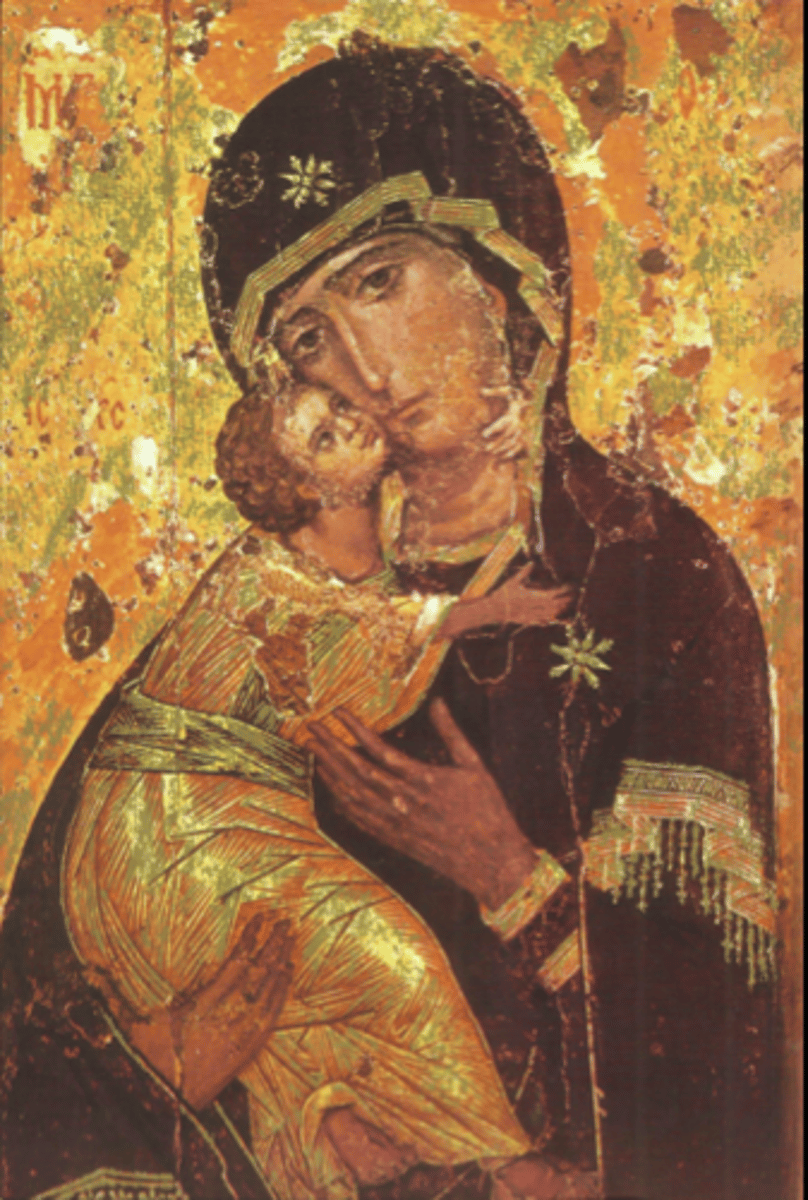
Who was Theophanes the Greek?
A Byzantine Greek artist that was one of the greatest fresco painters of Muscovite Russia working in Novgorod and Moscow (1340-1410)
Who was Andrei Rublev?
Apprentice to Theophanes the Greek (1360's - 1427), a great Russian icon painter that worked in Vladimir and Moscow
What is the name of this painting?
Trinity (1411 - 1427) most likely painted by Rublev.
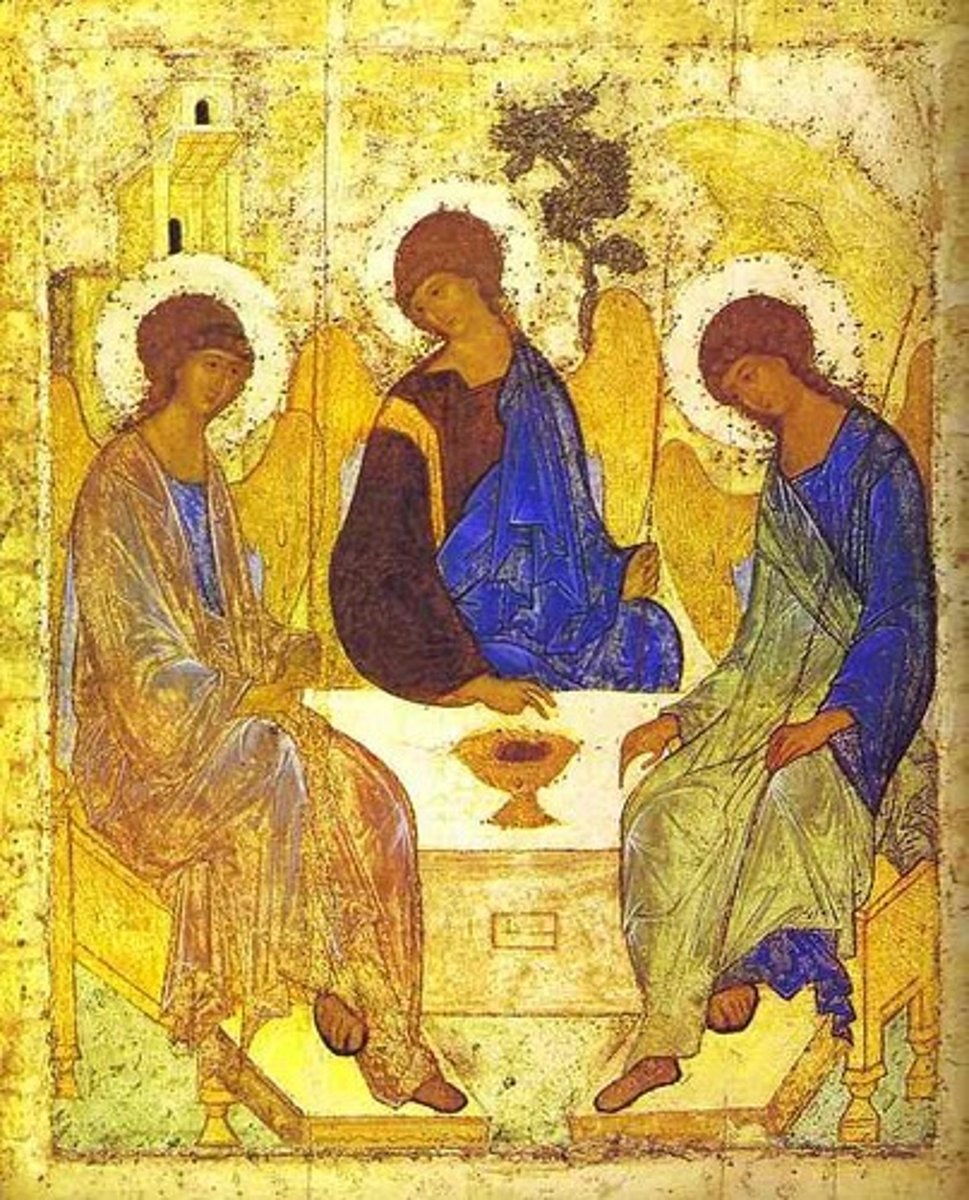
Who was Simon Ushakov?
An icon painter in the Tsars workshop (1626-1682), a part of church reforms taken on by Patriarch Nikon
What style do the Kremlin Cathedrals fall under?
15th century Italian Renaissance
When was the tent roof style employed in Russian architecture?
16th and 17th centuries
What cathedral is this?
Dormition Cathedral (1475-1479) built by Aristotele Fioravanti
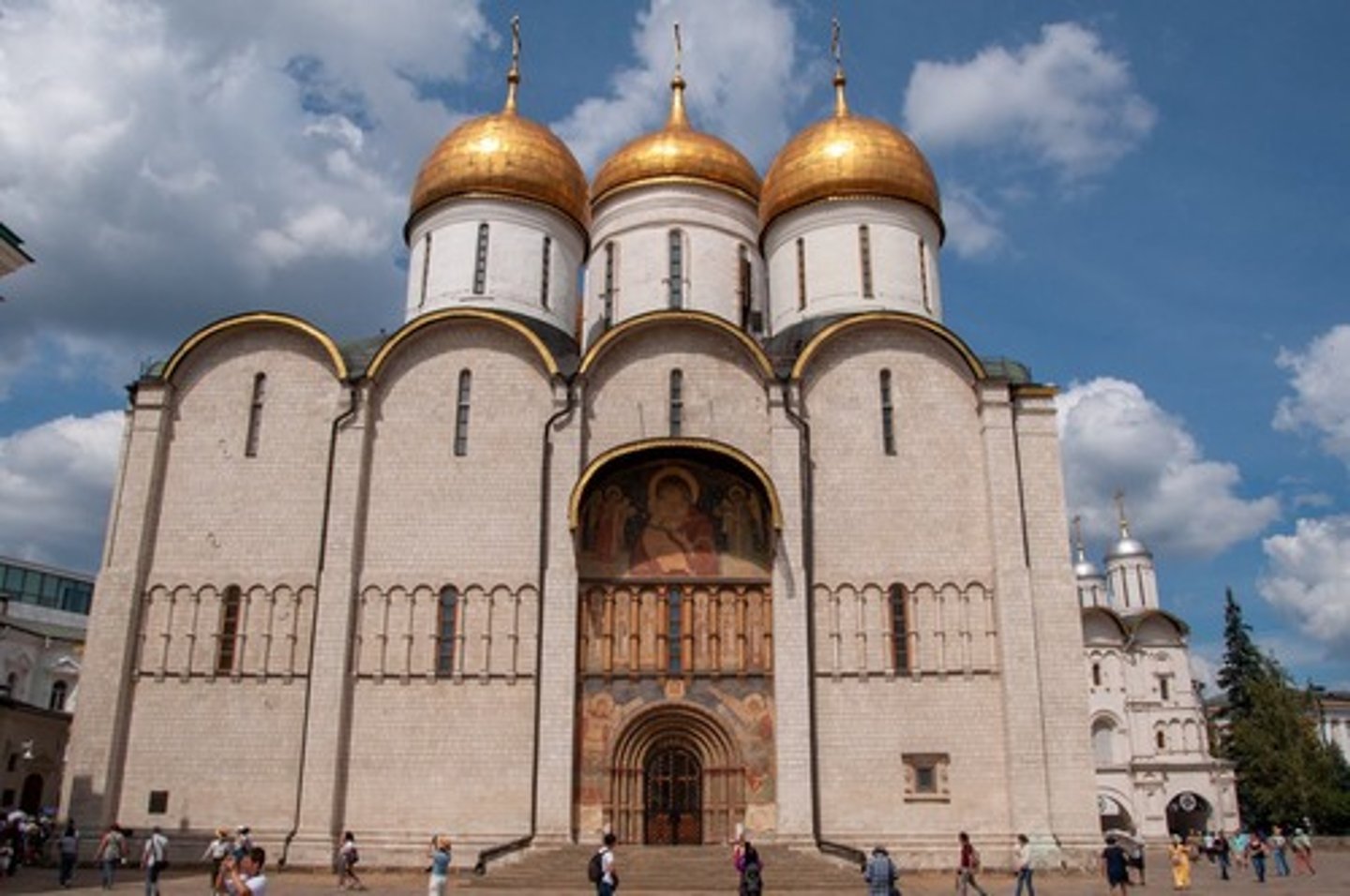
What is this cathedral called?
Annunciation Cathedral (1484-1489) built by Pskov masters
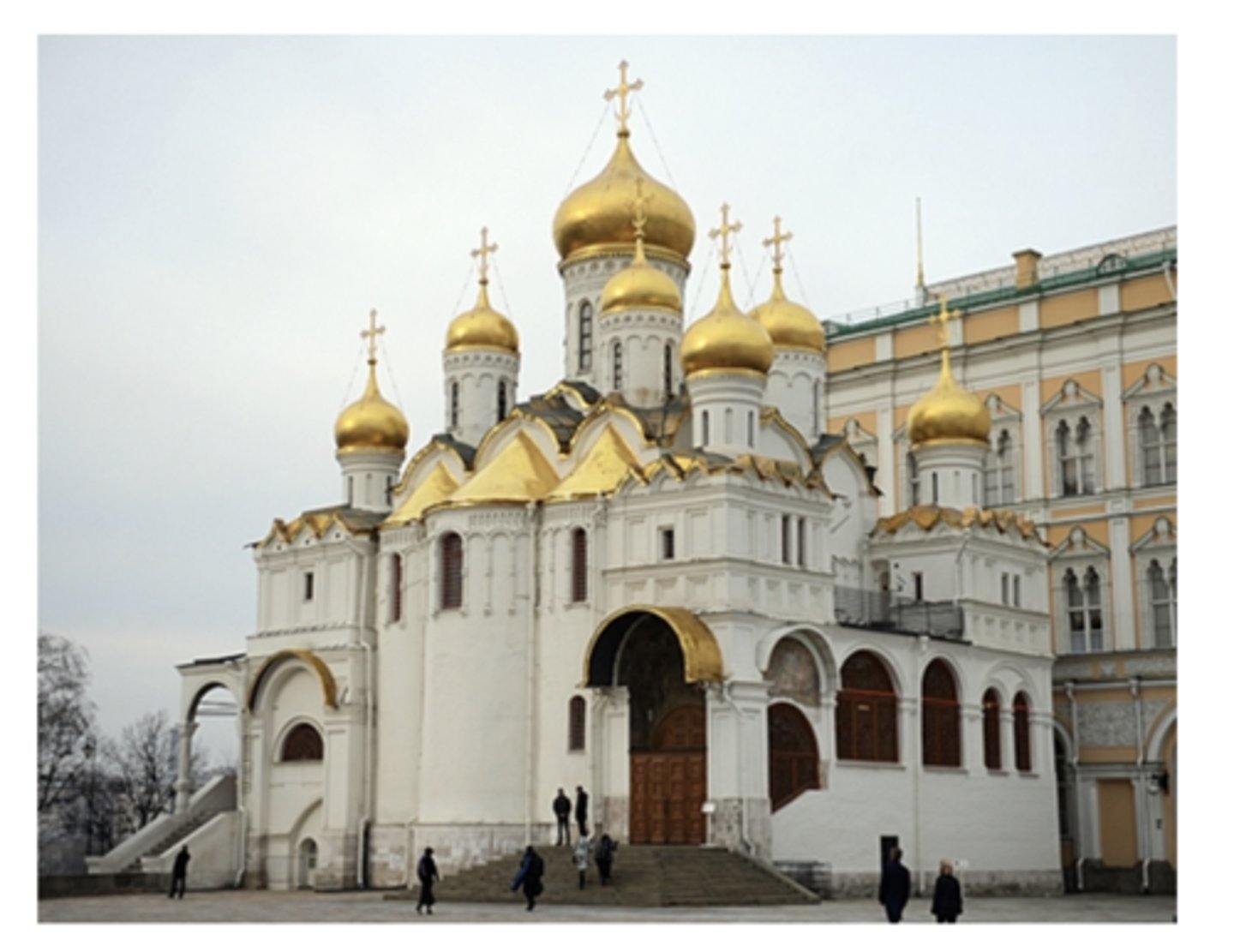
What is the name of this cathedral?
Cathedral of the Archangel (1505-1508) built by Alevisio "the New"
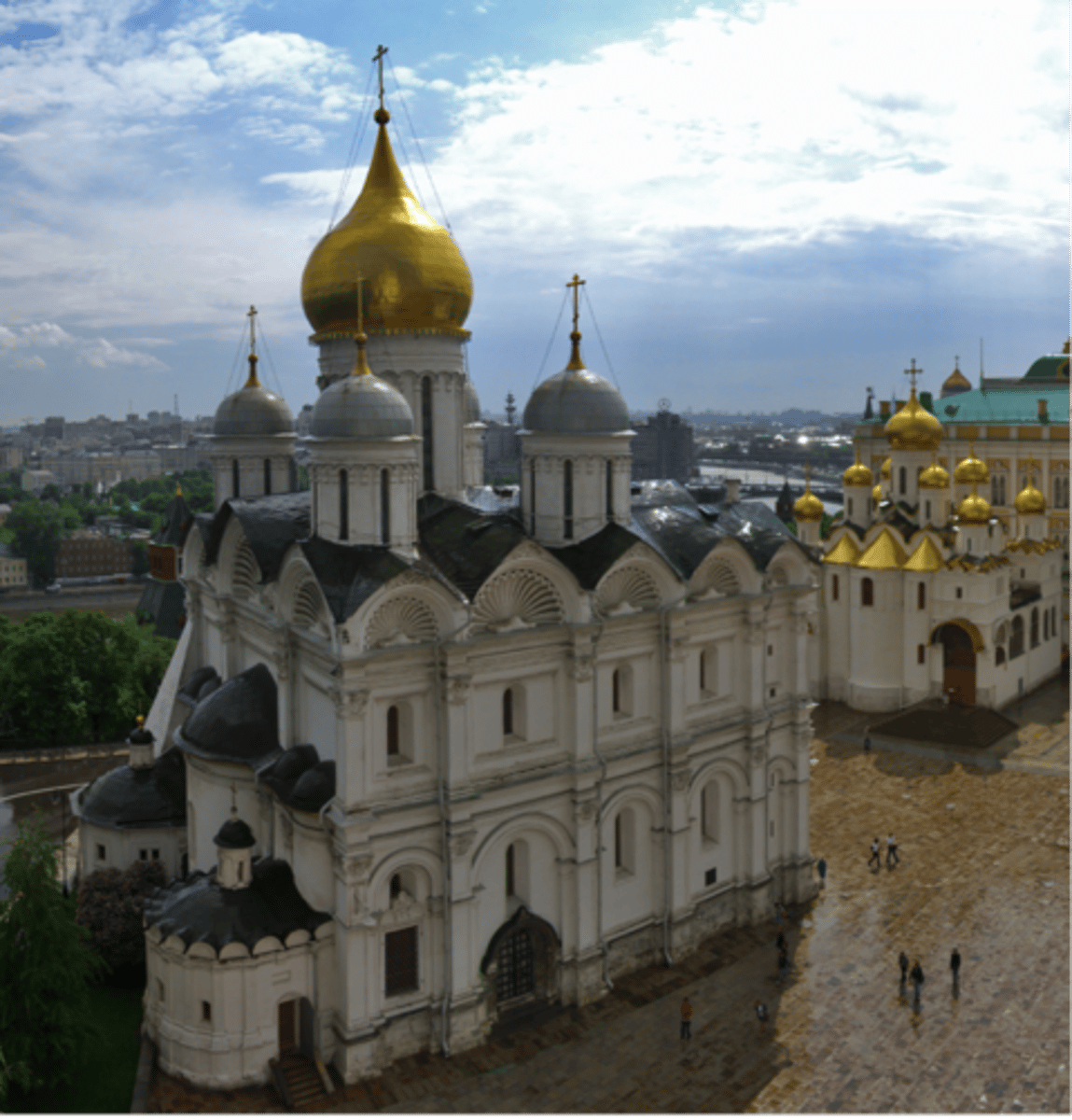
What is the name of this building?
Ivan the Great Bell Tower (1505-1508) built by Bon Friazin
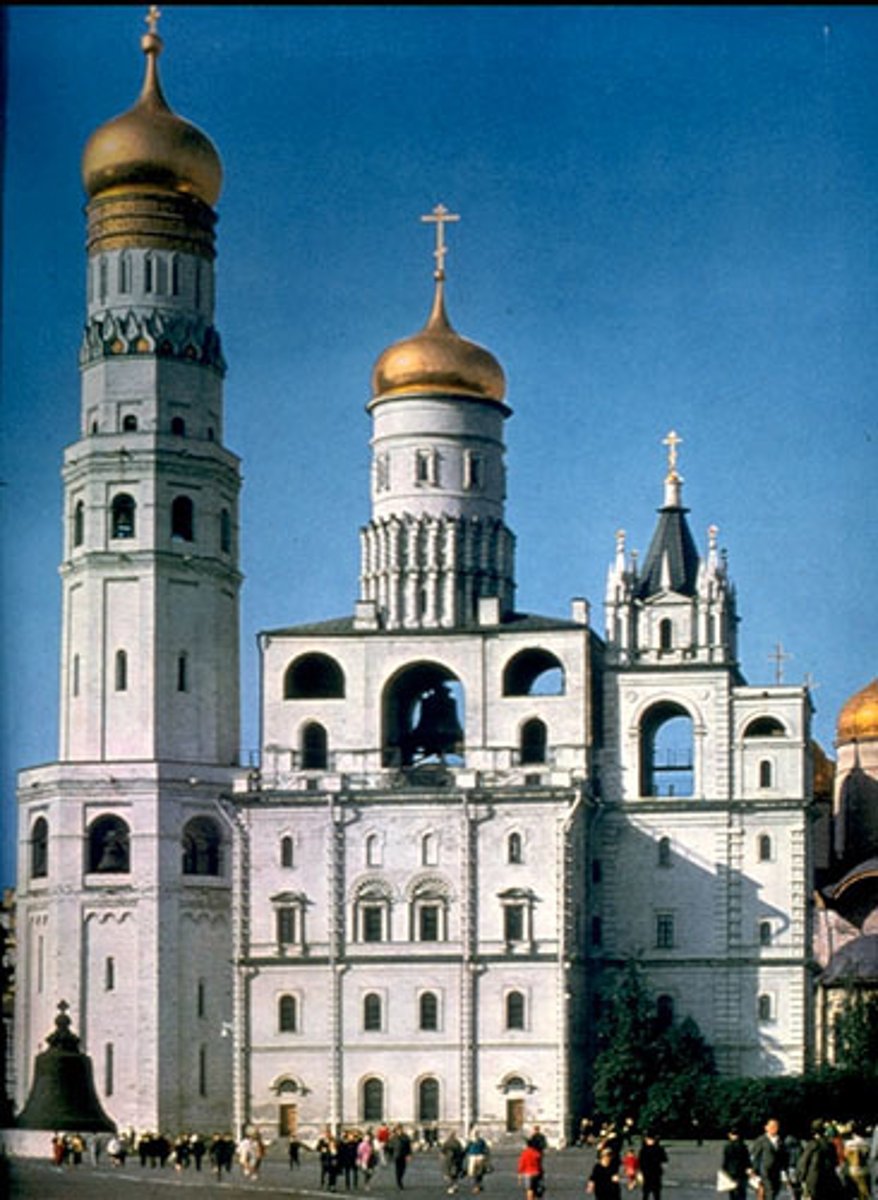
What is the name of this cathedral?
St. Basils Cathedral (16th century)

Who were the oprichnina?
The secrete police employed by Ivan the Terrible
What is the name of this?
Shapka Monomakha, "Oh, heavy lies the crown of Manomakh" from Pushkins Boris Godunov (14th century)
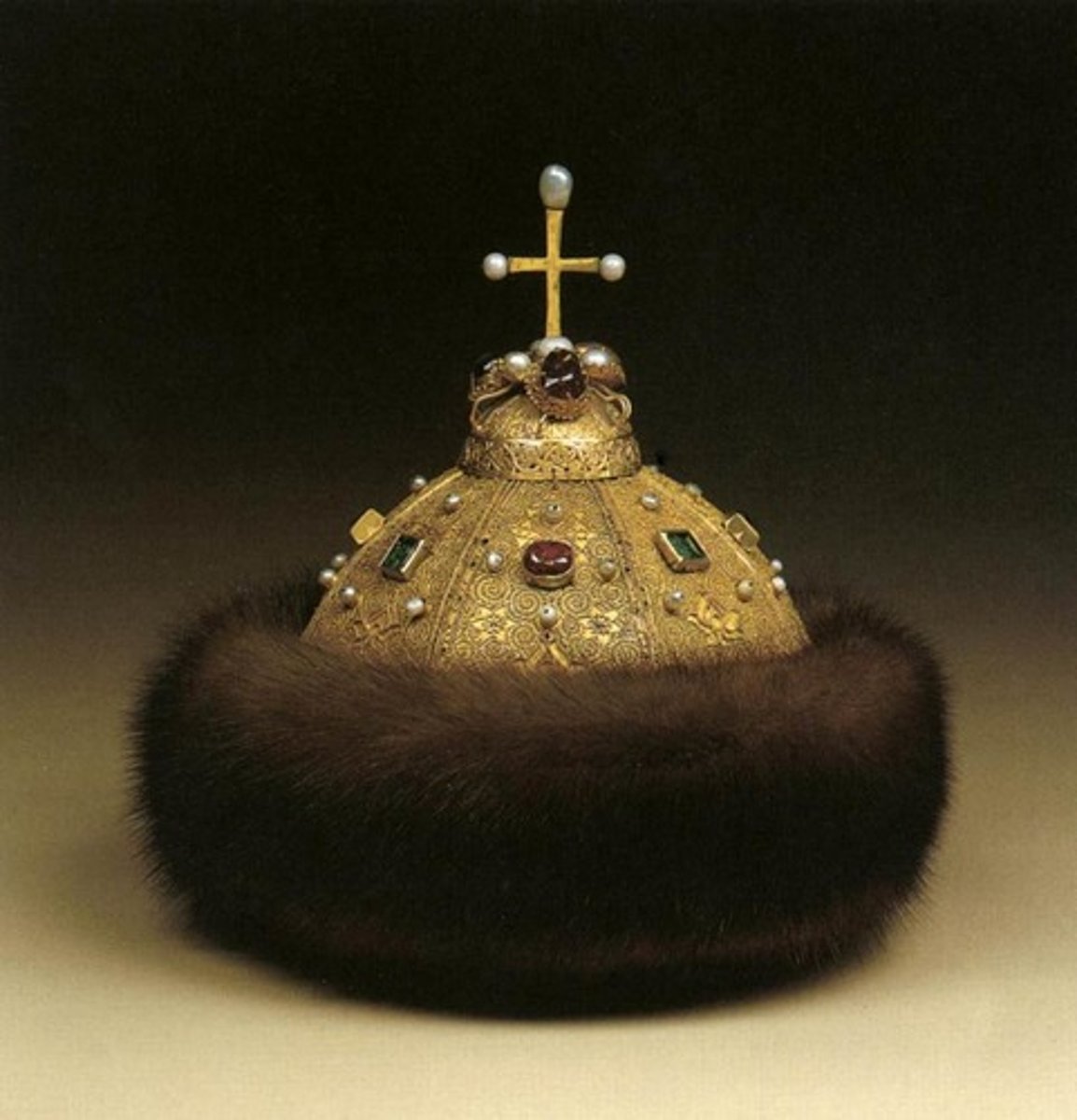
At what age did Ivan the Terrible become grand prince?
3 years of age
Who was the first to be crowned Tsar in Russian and when?
Ivan the terrible was the first to be crowned Tsar in Russia in 1547. His coronation was at the Dormition Cathedral.
Who was Ivan the Terrible first wife?
Anastasia Romanov of the boyar family (the first of four official and seven unofficial wives)
What was the Zemsky Sobor?
Appointed in 1549 by Ivan the Terrible, the Assembly of the Land sought approval for his reforms. This council of sorts was made up of boyars (old aristocracy), the clergy and commoners like merchants and townspeople (not peasants)
What was the Sudebnik?
A legal code established in 1550 by Ivan the Terrible.
What were the Prikazy?
Departments including Ambassadorial (Ministry of Foreign Affairs) established by Ivan the Terrible
Who was Ivan Fedorov?
Founder of Eastern Slavonic Russian printing (Moscow Print Yard was established under Ivan the Terrible's Rule)
What did Ivan Fedorov print in 1564?
Ivan printed the Apostle in Moscow
What did Ivan Fedorov print in 1581
Printed the Ostrong Bible, the first full printed version of the Old Church Slavonic Bible)
What happened in 1571?
Crimean Tatars attacked and burned Moscow. The Oprichnina failed to save the city and thus were abolished in 1572.
When was the Livonian War
1558-1583
What is the name of this painting?
Ivan the Terrible Killing his Son by Ilya Repin (1885)
